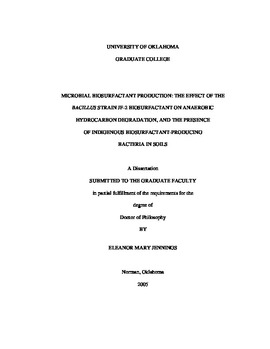| dc.contributor.advisor | Tanner, Ralph S., | en_US |
| dc.contributor.author | Jennings, Eleanor Mary. | en_US |
| dc.date.accessioned | 2013-08-16T12:19:47Z | |
| dc.date.available | 2013-08-16T12:19:47Z | |
| dc.date.issued | 2005 | en_US |
| dc.identifier.uri | https://hdl.handle.net/11244/859 | |
| dc.description.abstract | A series of experiments was designed utilizing the biosurfactant produced by Bacillus JF2. Specifically, these experiments were designed to determine if the presence of various levels of pre-purified JF2 biosurfactant would affect the degradation of a range of hydrocarbons under a variety of anaerobic conditions. A second goal of these experiments was to discern if in situ production of the JF2 biosurfactant would increase the degradation of these hydrocarbons to a greater degree than if the biosurfactant was added in its pre-purified form. These experiments have indicated how future work should proceed. This work also suggests that it may be more practical to stimulate indigenous biosurfactant producing bacteria within a soil than to add either pre-purified compound or to attempt in situ production. | en_US |
| dc.description.abstract | This manuscript includes a review of information regarding biosurfactants. A detailed description of the Bacillus species JF2 biosurfactant, including the genetics and physiology of biosurfactant production, is provided. Additionally, a comprehensive review of the literature regarding the use of biosurfactants in hydrocarbon degradation studies is included. | en_US |
| dc.description.abstract | The second portion of this dissertation investigates the presence of biosurfactant producing bacteria in uncontaminated and hydrocarbon contaminated soils. Prior research indicated that the number of bacterial biosurfactant producers in soil may be influenced by the presence of hydrocarbon contamination as well as levels of organic matter and fungi. The purpose of this study was to determine the relationship between soil organic matter levels, hydrocarbon contamination, numbers of fungi, and numbers of indigenous biosurfactant producers. Six soils were used: two hydrocarbon impacted soils, each paired with uncontaminated soil, and two pristine soils with different levels of organic matter. Gross numbers of fungi were higher in soils with higher levels of organic matter. Soils containing higher numbers of fungi contained a greater percentage of biosurfactant-producing aerobic heterotrophs, but only in the absence of a hydrocarbon. The percentage of biosurfactant producers was greater when hydrocarbon contamination was present. Additionally, the presence of the Bacillus subtilis srfA gene, which encodes a highly conserved region of the surfactant synthetase complex, was monitored directly in soils for the first time by PCR amplification and Southern hybridization. | en_US |
| dc.format.extent | xiii, 247 leaves : | en_US |
| dc.subject | Bacillus (Bacteria) | en_US |
| dc.subject | Biology, Microbiology. | en_US |
| dc.subject | Biosurfactants. | en_US |
| dc.title | Microbial biosurfactant production: The effect of the Bacillus strain JF-2 biosurfactant on anaerobic hydrocarbon degradation, and the presence of indigenous biosurfactant-producing bacteria in soils. | en_US |
| dc.type | Thesis | en_US |
| dc.thesis.degree | Ph.D. | en_US |
| dc.thesis.degreeDiscipline | Department of Microbiology and Plant Biology | en_US |
| dc.note | Adviser: Ralph S. Tanner. | en_US |
| dc.note | Source: Dissertation Abstracts International, Volume: 66-02, Section: B, page: 0703. | en_US |
| ou.identifier | (UMI)AAI3163315 | en_US |
| ou.group | College of Arts and Sciences::Department of Microbiology and Plant Biology | |
